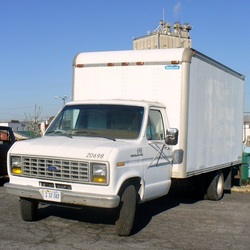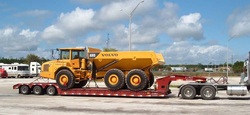 The zero emission Tyrano.
The zero emission Tyrano. This week I'm thinking about trucks a lot. So far, the best truck I've found to meet my sustainability needs is the Vision Corp Tyrano. It has a hydrogen fuel cell electric engine, but it's a Class 8 truck, bigger than I need. It weighs 17,000 lbs., which means I only have 9000 lbs left for everything else, if I want to stay under the 26,000 limit beyond which I'd need a commercial trucking license. But the issue I'm thinking the most about is how the truck will be attached to the living unit.
 Box trucks have the cargo van bolted to the frame.
Box trucks have the cargo van bolted to the frame. There are a number of ways to do this. I've eliminated the option most tiny home builders use, of building on a flatbed trailer hauled by a pickup truck. This works, though with significant challenges, for those who only want to relocate now and then, but I want to travel. A lot. So I need to have my housing unit either be an integrated part of the truck, more or less permanently attached to the cab, or attached in a way that keeps it more or less rigid, so it moves as a single piece, rather than bending at the point of attachment.
 A "low boy" trailer is closer to the ground.
A "low boy" trailer is closer to the ground. Another challenge is that I want the floor of the house to be closer to the ground than most trucking set ups are. They are designed for easy loading and unloading from typical cargo docks. I, on the other hand, want to increase my ceiling height to have more head room, while keeping the roof as low as I can. The legal height limit of 13.5 feet allows trucks to pass under overpasses, but overhead wires and tree branches on smaller roads are often much lower. For the best mobility, I need to hug the ground. But so far, lower floor options like "low boy" trailers all have the same safety issues as flatbed trailers--the risk of jackknifing, where the driver loses control of the movement of the trailer portion of the vehicle. At the suggestion of my cousin Glenn, I'm going to start talking to trucking engineers.
 RSS Feed
RSS Feed